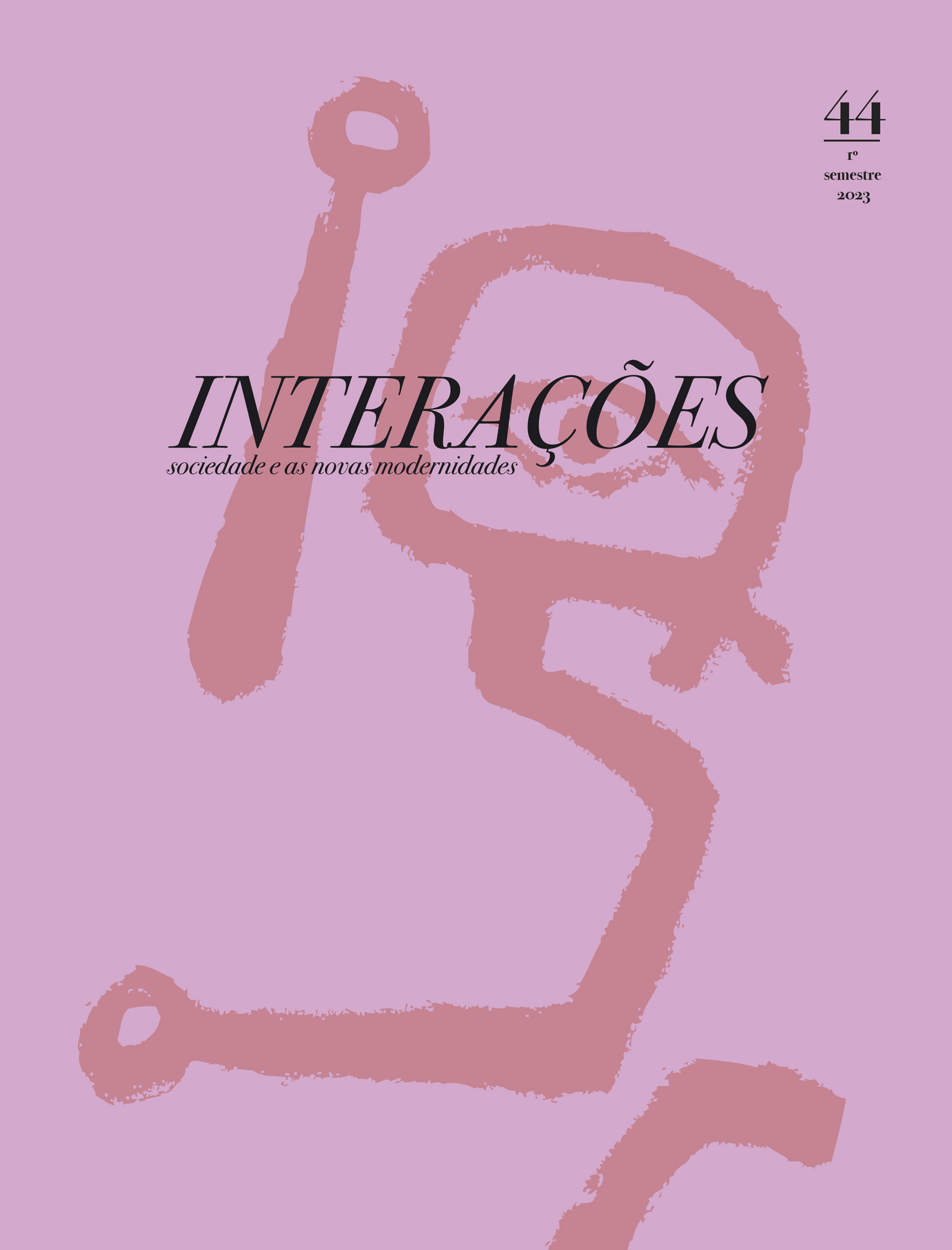Smart City as Participatory Environment
An Archaeological Exercise on How to Build a Political Community
DOI:
https://doi.org/10.31211/interacoes.n44.2023.a5Palavras-chave:
Cidades inteligentes, Arqueologia dos media, Transformação funcional, Arquivo, Curadoria digitalResumo
A Cidade Inteligente como Ambiente Participativo:
Um Exercício Arqueológico Sobre como Construir uma Comunidade Política
Existe ainda uma certa agitação em torno da ideia do que é uma Cidade Inteligente: para alguns, é uma preocupação, para outros é um campo aberto de enormes possibilidades. Originada na ubiquidade da computação imersiva em ambientes urbanos e implementada pela convergência entre vários meios de comunicação, uma Cidade Inteligente parece prometer eficiência agregada entre equipamentos, estruturas e indivíduos. Por outro lado, uma Cidade Inteligente parece simultaneamente limitar a cidadania a uma série de movimentos pré-estabelecidos, induzidos ou monitorados, anunciando uma espécie de vigilância voluntária. Inspirado em alguns trabalhos, este artigo tenta fornecer uma reflexão sobre o complexo dispositivo que uma Cidade Inteligente pode ser. Utilizando um exercício arqueológico, aborda a comunidade e o seu envolvimento na criação de lugares. Como uma rede de pessoas, arquiteturas, ferramentas e programas, uma cidade sempre foi um campo informativo e um ambiente suscetível a comandos, portanto de controle. Uma Cidade Inteligente pode não ser uma nova invenção, mas sim transformação de estruturas antigas com novos meios e materialidades, emergindo como resultado da difusão da tecnologia digital no espaço físico. Portanto, a questão não se baseia na tecnologia implantada, mas sim no caráter programático dos sistemas que ela instala. Afinal, na tecnologia pode residir o caminho para criar uma comunidade politicamente ativa e sensível.
Downloads
Referências
Agamben, G. (2009). What is an apparatus? In Kishik, D. and Pedatella, S. (Eds),What is an apparatus? and other essays (pp. 1-23). Stanford: Stanford University Press.
Arendt, H. (2005). The Promise of Politics. New York: Schocken Books.
Benjamin, W. (2002) The Arcades Project. Cambridge: Belknap Press.
Benjamin, W. (2005). The Author as Producer. In Selected Writings 1931-1934, (2)2, Cambridge: Belknap Press.
Benjamin, W. (1979). To the Planetarium. In One way street and other writings. London: New Left Books, 103-104.
Certeau, M. (1986). L’espace de l’archive ou la perversion du temps, Traverses, 36.
EC - European Commission (n.d.) Smart cities -Cities using technological solutions to improve the management and efficiency of the urban environment. https://commission.europa.eu/eu-regional-and-urban-development/topics/cities-and-urban-development/city-initiatives/smart-cities_en
Flusser, V. (2002). Designing Cities. In Writings (pp. 172-180). Minneapolis/London: University of Minnesota Press.
Gorgoglione, L., Malinverni, E. S., Smaniotto Costa, C., Pierdicca, R., & Di Stefano, F. (2023). Exploiting 2D/3D Geomatics Data for the Management, Promotion, and Valorization of Underground Built Heritage. Smart Cities, 6, 243-262. https://doi.org/10.3390/smartcities6010012
Gunning, T. (2003). Re-newing Old Technologies: Astonishment, Second Nature and the Uncanny in Technology from the Previous Turn-of-the-Century. In D. Thorburn, & H. Jenkins (Eds.), Rethinking media change: the aesthetics of transition (pp. 39-59). Cambridge: Mit Press.
Kittler, F. (1996). The City is a Medium. New Literary History (27), 717-729.
Leroi-Gourhan, A (1993). Gesture and Speech. Cambridge: Mit Press.
Mumford, L. (1961). The city in History: Its Origins, its transformations and its Prospects. New York: Harcourt.
Parikka, J. (2012). What is media archaeology? Cambridge: Polity Press.
Rodriguez, P. (2019). Las Palavras en las Cosas: Saber, Poder y Subjectivatión entre algoritmos y biomoléculas. Buenos Aires: Editorial Cactus.
Simondon, G. (2017). On the Mode of Existence of Technical Objects. London: Univocal.
Smaniotto Costa, C., Šuklje Erjavec, I., Kenna, T., de Lange, M., Ioannidis, K., Maksymiuk, G., de Waal, M. (Eds.) (2019). CyberParks – The Interface Between People, Places and Technology - New Approaches and Perspectives. Cham: Springer. https://doi.org/10.1007/978-3-030-13417-4
Smaniotto Costa, C., Volzone, R., Ruchinskaya, T., del Carmen Solano Báez, M.; Menezes, M., Ercan, M.A., & Rollandi, A. (2023). Smart Thinking on Co-Creation and Engagement: Searchlight on Underground Built Heritage. Smart Cities, 6, 392-409. https://doi.org/10.3390/smartcities6010019
Stiegler, B. (2014). Symbolic Misery. The Hyper-Industrial Epoch. Cambridge: Polity Press.
Toomey, A. H., Strehlau-Howay, L., Manzolillo, B., & Thomas, C. (2020). The place-making potential of citizen science: Creating social-ecological connections in an urbanized world. Landscape and Urban Planning, 200. https://doi.org/10.1016/j.landurbplan.2020.103824
Weber, M. (2005). The Protestant Ethic and the Spirit of Capitalism. London: Routledge.
Virilio, P. (2006). Speed and Politics. Los Angeles: Semiotexte.
Downloads
Publicado
Como Citar
Edição
Secção
Licença
Direitos de Autor (c) 2023 Catarina Patrício, Carlos Smaniotto Costa

Este trabalho encontra-se publicado com a Creative Commons Atribuição-NãoComercial 4.0.
Os direitos autorais dos trabalhos publicados são retidos pelo autor que outorga à Interações o direito de publicação original. O artigo publicado pode ser utilizado livremente para fins educacionais, não comerciais, em conformidade com a Licença Creative Commons - Atribuição-NãoComercial 4.0 Internacional, contando que seja citado o autor, o título do artigo, o título e número da revista conjuntamente com o URL ou DOI do artigo.



